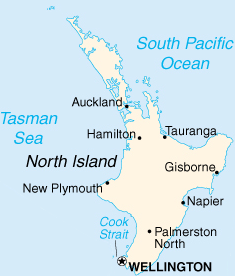North Island
North Island is one of the two main islands of New Zealand, the other being the South Island. It is separated from the South Island by the Cook Strait. The island is known for its vibrant culture, diverse landscapes, and significant historical sites.
Geography[edit | edit source]
North Island covers an area of approximately 113,729 square kilometers, making it the 14th largest island in the world. The island is characterized by its varied topography, which includes mountain ranges, rolling hills, and extensive coastlines. The highest point on the island is Mount Ruapehu, an active stratovolcano located in the central part of the island.
Regions[edit | edit source]
North Island is divided into several regions, each with its own unique features and attractions:
- Northland
- Auckland
- Waikato
- Bay of Plenty
- Gisborne
- Hawke's Bay
- Taranaki
- Manawatū-Whanganui
- Wellington
Major Cities[edit | edit source]
The North Island is home to some of New Zealand's largest and most important cities:
- Auckland - The largest city in New Zealand, known for its multicultural population and vibrant economy.
- Wellington - The capital city of New Zealand, located at the southern tip of the island.
- Hamilton - A major agricultural and educational center.
- Tauranga - A key port city in the Bay of Plenty region.
- Napier and Hastings - Twin cities known for their Art Deco architecture and wine production.
History[edit | edit source]
The North Island has a rich history that dates back to the arrival of the Māori people around the 13th century. The island was later explored by European navigators, including James Cook in the 18th century. The signing of the Treaty of Waitangi in 1840 marked a significant event in the island's history, establishing British sovereignty over New Zealand.
Economy[edit | edit source]
The economy of the North Island is diverse, with key industries including agriculture, manufacturing, tourism, and services. The island is known for its dairy farming, particularly in the Waikato region, as well as its wine production in areas such as Hawke's Bay and Gisborne.
Tourism[edit | edit source]
Tourism is a major industry in the North Island, attracting visitors with its natural beauty, cultural heritage, and outdoor activities. Popular tourist destinations include:
- Rotorua - Known for its geothermal activity and Māori culture.
- Bay of Islands - A popular spot for sailing and water sports.
- Tongariro National Park - A UNESCO World Heritage site featuring volcanic landscapes and hiking trails.
- Waitomo Caves - Famous for its glowworm caves and underground rivers.
Culture[edit | edit source]
The North Island is a cultural hub, with a rich blend of Māori and European influences. The island hosts numerous cultural festivals, museums, and art galleries. The Māori language and traditions are an integral part of the island's identity.
Transportation[edit | edit source]
The North Island has a well-developed transportation network, including highways, railways, and airports. Major airports include Auckland Airport, Wellington International Airport, and Hamilton Airport. The island is also connected to the South Island by ferry services across the Cook Strait.
See Also[edit | edit source]
References[edit | edit source]
External Links[edit | edit source]
Navigation: Wellness - Encyclopedia - Health topics - Disease Index - Drugs - World Directory - Gray's Anatomy - Keto diet - Recipes
Search WikiMD
Ad.Tired of being Overweight? Try W8MD's physician weight loss program.
Semaglutide (Ozempic / Wegovy and Tirzepatide (Mounjaro / Zepbound) available.
Advertise on WikiMD
WikiMD is not a substitute for professional medical advice. See full disclaimer.
Credits:Most images are courtesy of Wikimedia commons, and templates Wikipedia, licensed under CC BY SA or similar.Contributors: Prab R. Tumpati, MD





